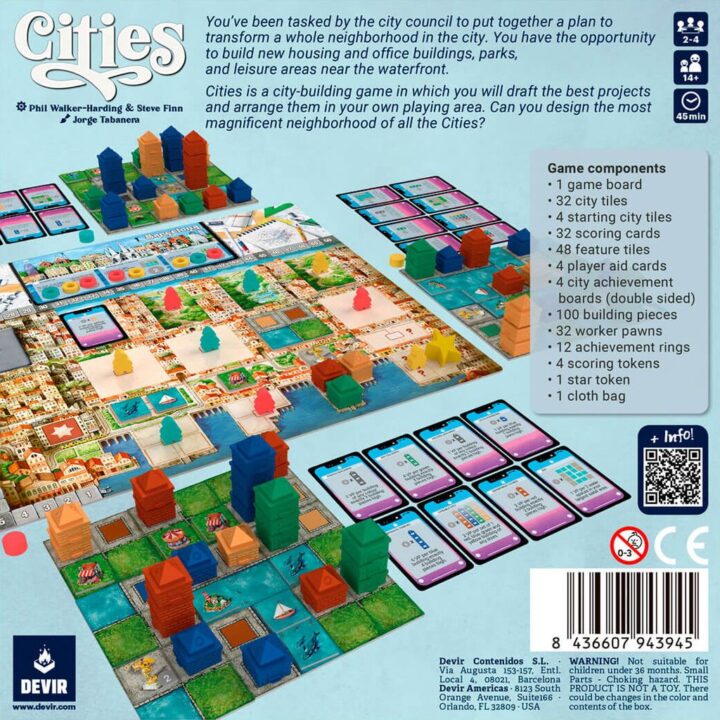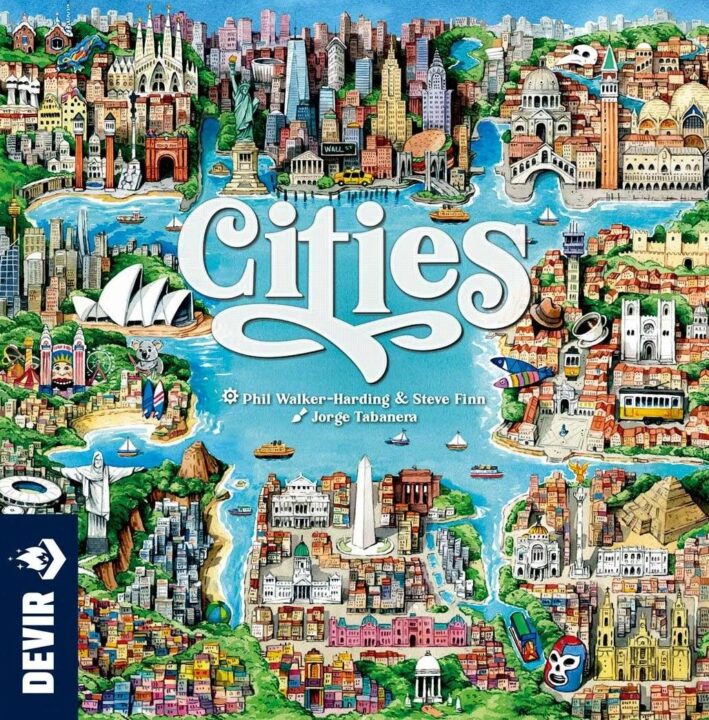Welcome to my review of Cities! Picture this: a board game where strategy meets delightful simplicity, with mechanics that make you cheer and groan in equal measure. From its beautiful artwork to its fair gameplay balance, Cities is a hit on game night. But, like any city, it has its quirks and hiccups. Ready for the full scoop? Let’s go!
How It Plays
Setting Up
First, you lay out the game board and give each player a set of city tiles. Make sure everyone has a player board and their own little stash of resources. Distribute a starting amount of resources and you’re good to go!
Gameplay
Players take turns placing their city tiles on the board. The goal is to expand their cities efficiently. Each tile has different features like parks, shops, and homes. You score points based on how well your city’s features work together. Don’t forget to collect resources on your turn!
Winning the Game
After a set number of rounds, tally up the points. Your score comes from how well you placed your tiles and used your resources. The player with the most points wins. Simple, right? Just remember, a well-planned city will always outperform a haphazard one.
Want to know more? Read our extensive strategy guide for Cities.
Gameplay Mechanics and Balance in Cities
I gotta say, ‘Cities’ surprised me in a good way. The gameplay mechanics are simple but delightful. You start with a blank city map and a deck of cards that represent different city elements like parks, factories, and residential areas. Each player takes a turn drawing and placing cards, trying to build the most prosperous city by balancing resources, pollution, and population growth.
The placement of cards is crucial. Every card has its own set of rules about where it can be placed and what it needs to thrive. For example, placing a factory too close to a residential area increases pollution, but placing parks near homes reduces stress and boosts population happiness. It’s a balancing act that keeps you on your toes.
Now, let’s talk about balance. I mean, who likes an unfair game? Not me, that’s for sure. ‘Cities’ does a fantastic job at keeping things fair. Everyone has the same starting resources and an equal shot at drafting the best cards. The game uses a neat drafting mechanic that makes it less about luck and more about strategy. This means your skill at planning your city layout and anticipating your opponents’ moves really pays off.
However, there is a minor hiccup. If you’ve got a player who’s a bit of a control freak with their city planning, it might slow down the game because they’re overthinking every placement. But hey, a few friendly nudges (or not-so-friendly jeers) usually do the trick to speed things up.
So, there you have it. The mechanics and balance of ‘Cities’ offer a satisfying and fair gameplay experience. Next, let’s explore how this game keeps everyone engaged and interacting, because what’s a city without its people, right?

Player Interaction and Engagement in Cities
If you enjoy games that keep everyone on their toes, then ‘Cities’ is a fine choice. My crew and I found that the game fostered both competition and cooperation, often in the same breath. Imagine this: you’re about to place a tile that will complete your grand city, but wait, Jen just placed her own tile blocking yours! The groans and laughter from that move alone were worth the price of the game.
One of the game’s best features is how it gets players talking. You can’t help but strategize out loud, trying to predict your friends’ moves. The constant guessing and mind-reading make for a dynamic atmosphere. The game also includes ‘trade’ moments where you can barter or plead for a better position. My friend Dave turned into quite the wheeler-dealer, offering up coffee runs in exchange for favorable trades. Yep, he’s that desperate for coffee and victory.
‘Cities’ balances out the engagement points with moments of quiet strategy. When everyone is plotting their next move, you can practically hear the gears turning in their heads. This balance makes the game feel lively without overwhelming players with too much chatter.
However, be warned, the game can stretch longer when people overthink their moves. It’s both a blessing and a curse, but it keeps everyone involved.
Next up, I’ll chat about the component quality and aesthetics. Let’s see if ‘Cities’ is as pretty to look at as it is fun to play.
Component Quality and Aesthetics in ‘Cities’
Let’s talk about the look and feel of ‘Cities’. The first thing that hits you is the beautiful artwork. It’s like strolling through a gallery, except your friends are there, and no one’s shushing you. The cityscapes are vibrant and detailed; you can almost hear the hustle and bustle of city life. Each card feels sturdy, like it could survive the wrath of a toddler or a clumsy friend who insists on handling everything with greasy fingers.
Now, the game pieces… Oh, the game pieces! They are not just pieces; they are tiny works of art. The buildings are in lovely pastel colors, and they fit together nicely on the board. The tactile experience is quite satisfying. You won’t feel like you’re handling cheap plastic here, no sir. The quality is top-notch, which is what you’d hope for because nobody wants their city’s infrastructure crumbling mid-game.
The board itself is well-designed, with clear icons and a layout that doesn’t make your eyes do gymnastics. It’s clean and intuitive, which helps keep the focus on your master city-building plans instead of trying to decipher hieroglyphics. The rulebook is another highlight. It’s concise and easy to understand, which is a godsend when you’re teaching the game to newbies.
However, I have to mention the minor quibble. Sometimes, the color choices for certain player pieces can be too similar, leading to mix-ups. A slight shade variation would fix this, but it’s a small gripe in an otherwise well-crafted game.
Now that we’ve marveled at the beauty and quality of ‘Cities’, let’s talk about its replay value and variability, shall we?
Replay Value and Variability in ‘Cities’
Let’s talk replay value and variability in ‘Cities’. Picture this—I’m sitting with my buddies, feeling victorious after our third round. I’m thinking, ‘Should we play again?’ Spoiler alert: the vote was a resounding yes.
‘Cities’ shines when it comes to replay value. Each game feels unique because the city tiles you draw and place change the landscape every time. Imagine setting up Tokyo one game, and then rebuilding it in a completely different way the next. This keeps the excitement alive, game after game. You won’t feel like you’re stuck in a monotonous routine.
Now, let’s talk variability. The game comes with a variety of city tiles and cards that add a lot of flavor. One time, you’ll focus on erecting skyscrapers; another time, you’ll be all about parks and rivers. This mix and match of elements ensures that each game session feels fresh.
I remember one night, we ended up with a city full of parks and no skyscrapers. My pal Dave jokingly called it ‘Greenville’. The next game? Total urban jungle! It’s these unpredictable scenarios that make ‘Cities’ so engaging.
Overall, the variability keeps everyone on their toes. You can’t rely on a fixed strategy, so you have to adapt. It’s like life in a real city—always changing. This adaptability means ‘Cities’ isn’t just collecting dust on your shelf.
Would I recommend ‘Cities’ for its replay value and variability? Absolutely. This game is worth every penny for the constant surprises it delivers. So, grab it, gather your friends, and get ready to build and rebuild!
Conclusion
So, that’s the end of our review of ‘Cities’. This game stands tall with its mix of strategy and simplicity. The artwork is top-notch and the pieces are solid. While there can be minor color confusion and moments of overthinking, the replay value keeps things fresh. It’s a game that balances competition and cooperation well, making each session engaging. Just watch out for analysis paralysis! Overall, ‘Cities’ is a strong addition to any game night. Happy city-building!


